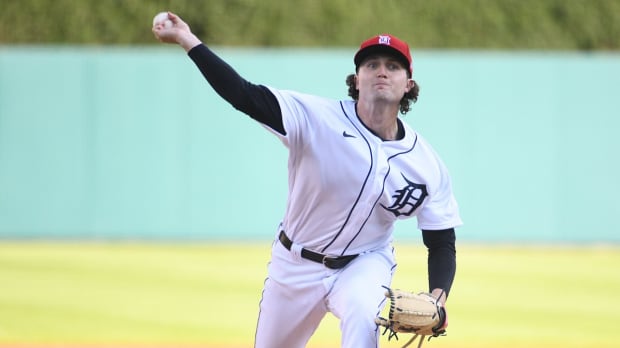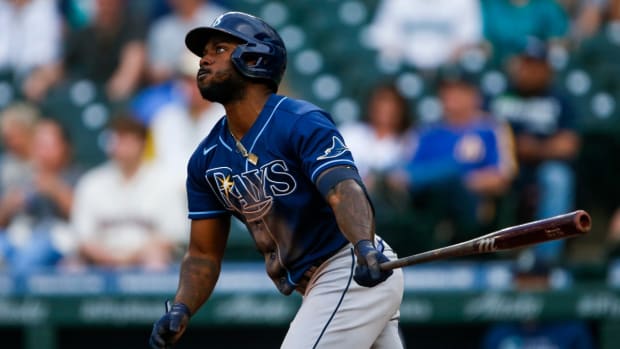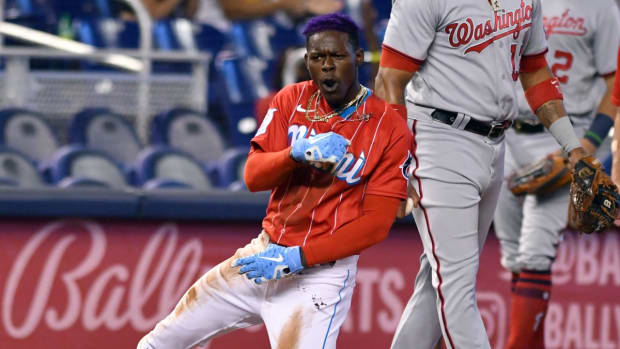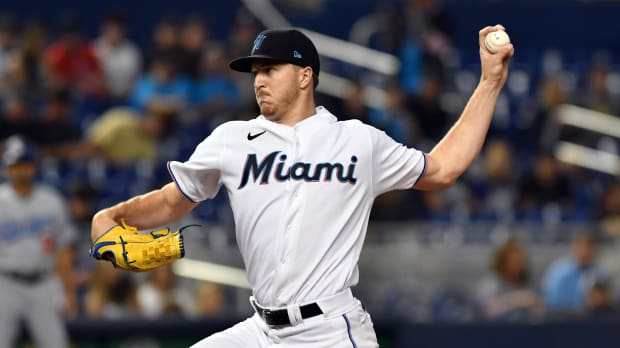As we've reached the midway point of the 2021 season, let's break down each league’s top Rookie of the Year contenders.
Of all the MLB awards, Rookie of the Year might be the most difficult to predict. It's hard to pinpoint not only which youngsters will burst onto the scene, but also when they’ll get called up. The yearslong odyssey of Minor League Baseball can be a winding journey that makes forecasting MLB arrivals a guessing game, particularly with service time manipulation used by front offices writ large.
That makes our preseason picks look somewhat ill-informed in hindsight. A lot has changed in the intervening three months, which makes now feel like as good a time as any to check in on the race to see who’s baseball’s best freshman. The first half of the season has not been short on rookie breakouts, with our two rookie All-Stars—Trevor Rogers and Adolis García—perhaps at the front of the line to take home some end-of-year hardware.
But they’ll certainly have their work cut out for them to hold off a talented field. Here are the contenders as we begin the second half.

American League
5. RP Emmanuel Clase, Cleveland
Monday’s blown save aside, Clase has been among the most dominant relief pitchers in the league through the season’s first half. Clase’s Statcast page is littered with red highlights, with few pitchers matching his electric stuff. His 100-mph cutter is the kind of pitch dreamt up while creating a player in MLB: The Show, but it’s his slider that’s the real moneymaker. Opposing batters have put up a meager .097 batting average with a .129 slugging percentage. Clase has split closer duties with James Karinchak so far and likely will continue to do so. Whether he closes or pitches in the setup role, he’s one of the most valuable late-inning weapons around.
4. SP Casey Mize, Tigers
Mize zipped through Detroit’s minor-league system and had a rough debut in 2020, posting a 6.99 ERA in seven starts. After two rough outings in April, the 2018 No. 1 pick has come into his own. He’s 4–3 with a 3.06 ERA in his last 12 starts, holding opposing hitters to a .217/.289/.348 slash line in that span. Mize has induced ground balls at a 50.8% clip, the 10th-highest mark among qualified starters. The underlying metrics haven’t painted as pretty a picture—Mize has a 5.00 expected ERA and an expected slugging percentage of .463—but he has as much talent as any young arm in the game.
3. SP Luis García, Astros
As good as the Astros have been on offense this season, it’s Houston’s rotation that’s been the key to the team’s first-half success. And García has played a crucial role after a brief but impressive debut in 2020. After moving to the rotation full-time at the end of April, García is 6–3 with a 3.17 ERA in 12 starts. He’s struck out 76 batters in 65 1/3 innings during that span, holding opposing hitters to a .216 batting average. García’s cutter and slider have been particularly lethal, with opponents batting .121 and .132, respectively, against those offerings.

2. OF Randy Arozarena, Rays
Last year’s postseason hero hasn’t quite set the world on fire in 2021 like he did last October. Yet the 26-year-old has still had a strong year, leading all rookies in runs scored (50) and ranking second in stolen bases (11). He’s hit well against fastballs this year (.322) but struggled mightily against breaking balls and off-speed pitches, whiffing more than 40% of the time. Arozarena set the bar unrealistically high during the playoffs last year, batting .372 with 10 home runs in 18 games. He might not ever be that hot again, but his first three months of 2021 shouldn’t be viewed as a disappointment.
1. OF Adolis García, Rangers
It’s hard to believe that, less than five months ago, the Rangers designated García for assignment just before the start of spring training. Luckily for Texas, the 28-year-old went unclaimed, and now he’ll represent the franchise at the All-Star Game next week. García swings and misses a ton, but when he makes contact he does serious damage. He ranks 10th among qualified hitters in barrels per plate appearance (10.0) and 27th in average exit velocity (91.4 mph), punishing fastballs at a .324 clip. García’s bat has cooled off a bit in the last month, and his free-swinging ways could lead to issues down the stretch, but he’s the prohibitive favorite at the moment.
Honorable mention: OF Akil Baddoo (Tigers), SP Cole Irvin (A’s), RP Michael Kopech (White Sox)

National League
5. C Tyler Stephenson, Reds
Stephenson spent five minor-league seasons working his way up to the bigs before a brief debut in 2020. He’s shown a preternatural feel for the strike zone, striking out just 17.6% of the time through his first 67 games. Stevenson’s lack of power in the minors—he slugged just .390 with 28 home runs in 1,556 plate appearances—might have been a minor cause for concern, but he’s improved in that regard this season. He’s slashing .272/.376/.428 with 18 extra-base hits so far, looking very much like Cincinnati’s catcher of the future. Stevenson doesn’t have as many plate appearances as the other hitters on this list, so he has a bit of catching up to do from a playing time standpoint. But if he continues to develop offensively, he has a chance to become just the fourth catcher in the past 30 years to win Rookie of the Year.
4. 2B/SS Jazz Chisholm Jr., Marlins
Chisholm hasn’t quite been the same since returning from the strained hamstring injury that kept him out for the first half of May. Before the injury, he was one of the most electrifying players of April, batting .290/.375/.551 with four homers and seven stolen bases in 21 games. Since returning on May 16, he’s hitting just .241/.294/.386 and has been caught stealing four times in seven attempts. Like many young hitters, Chisholm hunts fastballs but struggles with breaking balls, hitting .298 against the former and .157 against the latter. Though he strikes out nearly 32% of the time, Chisholm is not a free swinger, with a swing rate (45.8%) below league average. He has the 18th-highest called strike rate (19.7%) among batters with as many plate appearances, so perhaps swinging more often at pitches in the zone will help get him into favorable counts more frequently.
3. 2B Jonathan India, Reds
India put together one of the most successful college careers in recent memory—winning a national championship with Florida in 2017 before being named SEC Player of the Year in 2018—before the Reds made him the fifth overall pick in the 2018 draft. He was the team’s starting second baseman on Opening Day despite playing just 34 games at Double A in 2019 and not having a minor-league season last year. After a somewhat sluggish April and May, India has turned things around over the past month, batting .304/.435/.455 with five stolen bases in 31 games since June 1. India’s best attribute at the plate might be his feel for the strike zone, and he’s walked at a 12.5% clip through his first three months as a big leaguer. That bodes well for a relatively high offensive floor, and his ceiling could raise if he unlocks some as-of-yet untapped power—he slugged .717 with 21 homers in 68 games during his junior season with the Gators.
2. SP Ian Anderson, Braves
Like Arozarena, Anderson probably set expectations a touch too high for himself after shining in the postseason. He gave up just two runs with 24 strikeouts in 18 2/3 innings during Atlanta’s run to the NLCS after posting a 1.95 ERA in six regular season starts. When not compared to those results, Anderson’s “true” rookie season has been among the few bright spots in what’s been a tough season for the Braves. He’s still racking up ground balls at an impressive clip, and though his home run rate has nearly tripled compared to last season, he’s still among the league leaders in suppressing the long ball. Anderson’s changeup remains his bread and butter, ranking as the second-most effective changeup in the game, behind Miami’s Sandy Alcantara.

1. SP Trevor Rogers, Marlins
As by far the best rookie starter in this Year of the Pitcher, Rogers has a stranglehold on the award after an excellent first half. He has not allowed more than three runs in any of his first 16 starts, looking refined beyond his years after struggling in his first taste of the big leagues in 2020. Rogers uses his changeup to play off his mid-90s fastball with incredible effectiveness, with a developing slider that hitters whiff on 45% of the time. He has the third-lowest home run rate (0.48 HR/9) among qualified starters and would be in serious contention for the Cy Young Award if not for Jacob deGrom.
Honorable mention: 3B Patrick Wisdom (Cubs), OF Dylan Carlson (Cardinals), OF LaMonte Wade Jr. (Giants)
More MLB Coverage:
• Mickey Mantle, Chairman of the Cardboard
• Shohei Ohtani Isn't Babe Ruth—He's Better
• MLB Power Rankings: Handing Out First-Half Grades for Each Team
• The Charmed Season: Revisiting Derek Jeter’s Origin Story
As we've reached the midway point of the 2021 season, let's break down each league’s top Rookie of the Year contenders.
Of all the MLB awards, Rookie of the Year might be the most difficult to predict. It's hard to pinpoint not only which youngsters will burst onto the scene, but also when they’ll get called up. The yearslong odyssey of Minor League Baseball can be a winding journey that makes forecasting MLB arrivals a guessing game, particularly with service time manipulation used by front offices writ large.
That makes our preseason picks look somewhat ill-informed in hindsight. A lot has changed in the intervening three months, which makes now feel like as good a time as any to check in on the race to see who’s baseball’s best freshman. The first half of the season has not been short on rookie breakouts, with our two rookie All-Stars—Trevor Rogers and Adolis García—perhaps at the front of the line to take home some end-of-year hardware.
But they’ll certainly have their work cut out for them to hold off a talented field. Here are the contenders as we begin the second half.

American League
5. RP Emmanuel Clase, Cleveland
Monday’s blown save aside, Clase has been among the most dominant relief pitchers in the league through the season’s first half. Clase’s Statcast page is littered with red highlights, with few pitchers matching his electric stuff. His 100-mph cutter is the kind of pitch dreamt up while creating a player in MLB: The Show, but it’s his slider that’s the real moneymaker. Opposing batters have put up a meager .097 batting average with a .129 slugging percentage. Clase has split closer duties with James Karinchak so far and likely will continue to do so. Whether he closes or pitches in the setup role, he’s one of the most valuable late-inning weapons around.
4. SP Casey Mize, Tigers
Mize zipped through Detroit’s minor-league system and had a rough debut in 2020, posting a 6.99 ERA in seven starts. After two rough outings in April, the 2018 No. 1 pick has come into his own. He’s 4–3 with a 3.06 ERA in his last 12 starts, holding opposing hitters to a .217/.289/.348 slash line in that span. Mize has induced ground balls at a 50.8% clip, the 10th-highest mark among qualified starters. The underlying metrics haven’t painted as pretty a picture—Mize has a 5.00 expected ERA and an expected slugging percentage of .463—but he has as much talent as any young arm in the game.
3. SP Luis García, Astros
As good as the Astros have been on offense this season, it’s Houston’s rotation that’s been the key to the team’s first-half success. And García has played a crucial role after a brief but impressive debut in 2020. After moving to the rotation full-time at the end of April, García is 6–3 with a 3.17 ERA in 12 starts. He’s struck out 76 batters in 65 1/3 innings during that span, holding opposing hitters to a .216 batting average. García’s cutter and slider have been particularly lethal, with opponents batting .121 and .132, respectively, against those offerings.

2. OF Randy Arozarena, Rays
Last year’s postseason hero hasn’t quite set the world on fire in 2021 like he did last October. Yet the 26-year-old has still had a strong year, leading all rookies in runs scored (50) and ranking second in stolen bases (11). He’s hit well against fastballs this year (.322) but struggled mightily against breaking balls and off-speed pitches, whiffing more than 40% of the time. Arozarena set the bar unrealistically high during the playoffs last year, batting .372 with 10 home runs in 18 games. He might not ever be that hot again, but his first three months of 2021 shouldn’t be viewed as a disappointment.
1. OF Adolis García, Rangers
It’s hard to believe that, less than five months ago, the Rangers designated García for assignment just before the start of spring training. Luckily for Texas, the 28-year-old went unclaimed, and now he’ll represent the franchise at the All-Star Game next week. García swings and misses a ton, but when he makes contact he does serious damage. He ranks 10th among qualified hitters in barrels per plate appearance (10.0) and 27th in average exit velocity (91.4 mph), punishing fastballs at a .324 clip. García’s bat has cooled off a bit in the last month, and his free-swinging ways could lead to issues down the stretch, but he’s the prohibitive favorite at the moment.
Honorable mention: OF Akil Baddoo (Tigers), SP Cole Irvin (A’s), RP Michael Kopech (White Sox)

National League
5. C Tyler Stephenson, Reds
Stephenson spent five minor-league seasons working his way up to the bigs before a brief debut in 2020. He’s shown a preternatural feel for the strike zone, striking out just 17.6% of the time through his first 67 games. Stevenson’s lack of power in the minors—he slugged just .390 with 28 home runs in 1,556 plate appearances—might have been a minor cause for concern, but he’s improved in that regard this season. He’s slashing .272/.376/.428 with 18 extra-base hits so far, looking very much like Cincinnati’s catcher of the future. Stevenson doesn’t have as many plate appearances as the other hitters on this list, so he has a bit of catching up to do from a playing time standpoint. But if he continues to develop offensively, he has a chance to become just the fourth catcher in the past 30 years to win Rookie of the Year.
4. 2B/SS Jazz Chisholm Jr., Marlins
Chisholm hasn’t quite been the same since returning from the strained hamstring injury that kept him out for the first half of May. Before the injury, he was one of the most electrifying players of April, batting .290/.375/.551 with four homers and seven stolen bases in 21 games. Since returning on May 16, he’s hitting just .241/.294/.386 and has been caught stealing four times in seven attempts. Like many young hitters, Chisholm hunts fastballs but struggles with breaking balls, hitting .298 against the former and .157 against the latter. Though he strikes out nearly 32% of the time, Chisholm is not a free swinger, with a swing rate (45.8%) below league average. He has the 18th-highest called strike rate (19.7%) among batters with as many plate appearances, so perhaps swinging more often at pitches in the zone will help get him into favorable counts more frequently.
3. 2B Jonathan India, Reds
India put together one of the most successful college careers in recent memory—winning a national championship with Florida in 2017 before being named SEC Player of the Year in 2018—before the Reds made him the fifth overall pick in the 2018 draft. He was the team’s starting second baseman on Opening Day despite playing just 34 games at Double A in 2019 and not having a minor-league season last year. After a somewhat sluggish April and May, India has turned things around over the past month, batting .304/.435/.455 with five stolen bases in 31 games since June 1. India’s best attribute at the plate might be his feel for the strike zone, and he’s walked at a 12.5% clip through his first three months as a big leaguer. That bodes well for a relatively high offensive floor, and his ceiling could raise if he unlocks some as-of-yet untapped power—he slugged .717 with 21 homers in 68 games during his junior season with the Gators.
2. SP Ian Anderson, Braves
Like Arozarena, Anderson probably set expectations a touch too high for himself after shining in the postseason. He gave up just two runs with 24 strikeouts in 18 2/3 innings during Atlanta’s run to the NLCS after posting a 1.95 ERA in six regular season starts. When not compared to those results, Anderson’s “true” rookie season has been among the few bright spots in what’s been a tough season for the Braves. He’s still racking up ground balls at an impressive clip, and though his home run rate has nearly tripled compared to last season, he’s still among the league leaders in suppressing the long ball. Anderson’s changeup remains his bread and butter, ranking as the second-most effective changeup in the game, behind Miami’s Sandy Alcantara.

1. SP Trevor Rogers, Marlins
As by far the best rookie starter in this Year of the Pitcher, Rogers has a stranglehold on the award after an excellent first half. He has not allowed more than three runs in any of his first 16 starts, looking refined beyond his years after struggling in his first taste of the big leagues in 2020. Rogers uses his changeup to play off his mid-90s fastball with incredible effectiveness, with a developing slider that hitters whiff on 45% of the time. He has the third-lowest home run rate (0.48 HR/9) among qualified starters and would be in serious contention for the Cy Young Award if not for Jacob deGrom.
Honorable mention: 3B Patrick Wisdom (Cubs), OF Dylan Carlson (Cardinals), OF LaMonte Wade Jr. (Giants)
More MLB Coverage:
• Mickey Mantle, Chairman of the Cardboard
• Shohei Ohtani Isn't Babe Ruth—He's Better
• MLB Power Rankings: Handing Out First-Half Grades for Each Team
• The Charmed Season: Revisiting Derek Jeter’s Origin Story


0 Comments